NCERT Solutions for Class 12 Accountancy Part II Chapter 2 Issue and Redemption of Debentures
NCERT Solutions CBSE Sample Papers AccountancyClass 12 Accountancy
DO IT YOURSELF I
1. Amrit Company Limited purchased assets of the book value of Rs.2,20,000 fromanother company and agreed to make the payment of purchase consideration by issuing 2,000, 10% debentures of Rs.100 each at a premium of 10%. Record necessary journal entries.
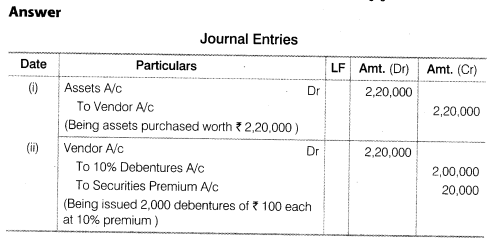
2. A company purchased assets of the value of Rs.1,90,000 from another company and agreed to make the payment of purchase consideration by issuing 2,000,10% debentures of Rs.100 each at a discount of 5%. Record necessary journal entries.

3. Rose Bond Limited purchased a business for Rs. 22,00,000. Purchase Price was paid by 6% debentures. Debentures of Rs. 20,00,000 were issued at a premium of 10% for the purpose. Record necessary journal entries.

4. Nikhil and Ashwin Limited bought business of Agarwal Limited consisting sundry assts of Rs. 3,60,000, sundry creditors Rs. 1,00,000 for a consideration ofRs. 3,07,200. It issued 14% debentures of Rs. 100 each fully paid at a discount of 4% in satisfaction of purchase consideration. Record necessary journal entries.


Note If business is purchased and assets and liabilities are mentioned along with purchase price, pass a journal entry. To balance the entry use word ‘Goodwill’ if difference is on debit side and word ‘Reserves’ if difference is on credit side.
DO IT YOURSELF II
2. Record necessary journal entries in each of the following cases:
a. 27,000, 7% debentures of Rs. 100 each issued at par, redeemable at par.
b. 25,000, 7% debentures of Rs. 100 each issued at par redeemable at 4% premium.
c. 20,000, 7% debentures of Rs. 100 each issued at 5% discount and redeemable at par.
d. 30,000, 7% debentures of 100 each issued at 5% discount and redeemable at 2½ % premium.
e. 35,000, 7% debentures of Rs. 100 each issued at 4% premium and redeemable.
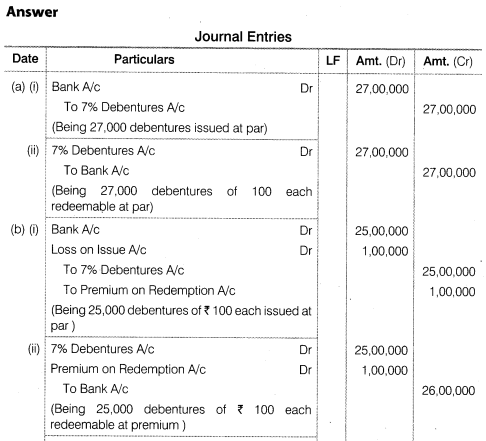
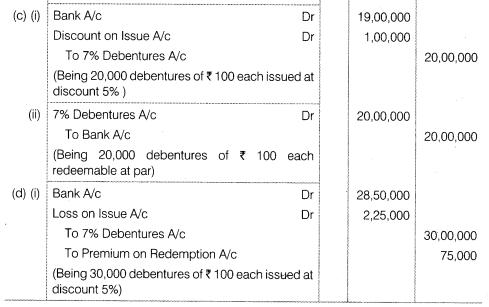

DO IT YOURSELF III
1. Diwakar enterprises Ltd. Issued 10,00,000, 6% debentures on April 1, 2002. Interest is paid on September 30, 2002 and March 31, 2003.
Record necessary journal entries assuming that income tax is deducted @30% of the amount of interest.
(Amount of tax Rs.18,000 for the year ending March 31, 2003)



2. Laser India Ltd. Issued 7,00,000, 8% debentures of Rs. 100 each at par.Company deducts income tax from the interest of these debentures at source. Interest is to be paid on these debentures half-yearly on September 30 andMarch 31, every year. Amount of income tax deducted half-yearly iRs. 2,80,000.


DO IT YOURSELF IV
1. X Ltd. Issued 2,000, 10% debentures of Rs.100 each at a discount of 8% on1 Jan, 1992 which are redeemable at par by annual drawings in 4 yearscommencing from 31st March 1993 as per the following redemption plan:Ist Draw 10%, 2nd Draw 20%, 3rd Draw 30%, and 4th Draw 40%. Calculate theamount of discount to be written-off each year assuming that X Ltd. followscalendar year as its accounting year.

2. Z Ltd. issued 15,00,000, 10% debenture of Rs.50 each at premium of 10% payable as Rs.20 on application and balance on allotment. Debentures are redeemable at par after 6 years. All the money due on allotment was calledand duly received. Record necessary entries when premium money is included:
(i) in application money
(ii) in allotment money


3. Z Ltd. issued 5,000, 10% debentures of Rs.100 each at a discount of 10% on 1.1.2005. The debentures are to be redeemed every year draw of lots – 1,000 debenture to be redeemed every year starting on 31.12.2005. Record the necessary journal entries including the payment of interest and writing off the discount on issue of debentures. The interest is payable on 30th June and 31st December. Z Ltd. Closes its books of accounts on 31st December.




4. M Ltd. issued 10,000, 8% debentures of Rs.100 each at a premium of 10% on 1.1.2004. It purchased sundry assets of the value of Rs,2,50,000 and took over the liabilities of Rs,1,90,000 and issued 8% debentures at a discount of 5% to the vendor. On the same date it took loan from the Bank for Rs.1,00,000 and issued 8% debentures as Collateral Security. Record the relevant journal entries in the books of M Ltd. and prepare the extract of balance sheet on 31.12.2004. Ignore interest.



5. On 1.1.2005 Fast Computers Ltd. issued 20,00,000, 6% debentures of Rs.100 each at a discount of 4%, redeemable at a premium of 5% after three years.
The amount was payable as follows:
On application Rs.50 per debenture,
Balance on allotment,
Record the necessary journal entries for issue of debentures.



6. D Ltd. Purchased machinery worth Rs.2,00,000 from E Ltd. on 1.1.2001. Rs.50,000 were paid immediately and the balance was paid by issue of Rs.1,60,000, 12% Debentures in D Ltd. Record the necessary journal entries for recording the transactions in the books of D Ltd.

TEST YOUR UNDERSTANDING I
• State whether the following statements are True (T) or Fasle (F)
Question 1. Debenture is written instrument acknowledging a debt under the common seal of the company.
Answer True
Question 2. Debenture is a part of owned capital.
Answer False
Question 3. The payment of interest on debentures is a charge on the profits of the company.
Answer True
Question 4. The debentures cannot be issued at a discount of more than 10% of the face value.
Answer False
Question 5. Redeemable debentures are those debentures, which are payable on the expiry of the specific period.
Answer True
Question 6. Perpetual debentures are also known as irredeemable debentures.
Answer True
Question 7. Debentures cannot be converted into shares.
Answer False
Question 8. Debentures cannot be issued at a premium.
Answer False
Question 9. A Collateral Security is a Subsidiary Security.
Answer True
Question 10. Debentures cannot be issued at a premium and redeemable at par.
Answer False
Question 11. Loss on issue of debentures account is a revenue loss.
Answer False
Question 12. Premium on redemption of debentures account is shown under the ‘Securities Premium’ in the Balance Sheet.
Answer False
DO IT YOURSELF V
1. X Ltd. decides to redeem 8,000, 10% debentures of Rs.100 each on January 1, 2004 at a premium of 5%. The company has a balance of Rs.9, 00,000 at the credit of its profit and loss account. The company closes its books on December 31 every year. What journal entries the company will be recorded to redeem the above debentures.

2. G Ltd. issued 5,00,000, 12 % debenture of Rs.100 each on April 1, 2002 redeemable at par on July 1, 2003. The company received applications for 6,00,000 debentures and the allotment was made to all the applicants on pro-rata basis. The debenture were redeemed on due date. How much amount of Debenture Redemption Reserve is to be created before the redemption is carried out? Also record necessary journal entries regarding issue and redemption of debenture. Ignore tax deducted at source.

TEST YOUR UNDERSTANDING II
Select the correct answer for the following multiple choice questions:
1. Debentures which are transferable by mere delivery are:
(a) Registered debentures, (b) First debentures,
(c) Bearer debentures.
2. The following journal entry appears in the books of X Co. Ltd.

Question 3. X Co Ltd purchased assets worth ? 28,80,000. It issued debentures of ? 100 each at a discount of 4% in full satisfaction of the purchase consideration. The number of debentures issued to vendor is
(a) 30,000 (b) 28,800 (c) 32,000
Answer (a) 30,000
Question 4. Convertible debentures cannot be issued at a discount if 1 (a) they are to be immediately converted
(b) they are not to be immediately converted
(c) None of the above
Answer (a) They are to be immediately converted
Question 5. Discount on issue of debentures is shown under the following head in the Balance Sheet
(a) Profit and loss account
(b) Miscellaneous expenditure
(c) Debentures account
Answer (b) Miscellaneous expenditure
Question 6. When debentures are issued at par and are redeemable at a premium, the loss on such an issue debited to
(a) Profit and loss account
(b) Debentures applications and allotment account
(c) Loss on issue of debentures account
Answer (c) Loss on issue of debentures account
Question 7. Excess value of net assets over purchase consideration at the time of purchase of business is credited to
(a) General reserve
(b) Capital reserve
(c) Vendor’s account
Answer (b) Capital reserve
Question 8. When all the debentures are redeemed, balance in the debentures redemption fund account is transferred to
(a) Capital reserve
(b) General reserve
(c) Profits and loss appropriation account
Answer (b) General reserve
Question 9. The nominal and book values of debenture redemption fund investments account are respectively ? 1,00,000 and ? 96,000.
The company sold investments of nominal value of? 30,000 at a price which was just sufficient to redeem debentures of ? 30,000 at 10% premium, the profit on sale of investment is
(a) Rs. 4,200 (b)Rs. 3,000 (c) Nil
Answer (a) Rs. 4,200
Question 10. Own debentures are those debentures of the company which
(a) the company allots to its own promoters
(b) the company allots to its Director
(c) the company purchase from the market and keeps them as investments
Answer (c) The company purchase from the market and keeps them as investments
Question 11. Profit on cancellation of own debentures is transferred to
(a) Profit and loss appropriation account
(b) Debenture redemption reserve
(c) Capital reserve
Answer (c) Capital reserve
Question 12. When debentures are redeemed out of profits, an equal amount is transferred to
(a) General reserve
(b) Debenture redemption reserve
(c) Capital reserve
Answer (b) Debenture redemption reserve
Question 13. Profit on sale of debenture redemption fund investments in the first instance is credited to
(a) Debenture redemption fund account
(b) Profit and loss appropriation account
(c) General reserve account
Answer (a) Debenture redemption fund account
Question 14. The balance of sinking fund investment account after the realisation of investments is transferred to
(a) Profit and loss account
(b) Debentures account
(c) Sinking fund account
Answer (c) Sinking fund account
Question 15. When debentures are issued at a discount and are redeemable at a premium, which of the following accounts is debited at the time of issue
(a) Debentures account
(b) Premium on redemption of debentures account
(c) Loss on issue of debentures account
Answer (c) Loss on issue of debentures account .
TEST YOUR UNDERSTANDING III
• Indicate in the column below, the account to be debited in case of the following transactions.
Transaction Account to be Debited
Question 1. Issue of debentures to a vendor in consideration of the business purchase.
Question 2. Setting aside the amount for creating sinking fund for redemption of debentures.
Question 3. The balance of debenture redemption reserve account after redemption of the debentures.
Question 4. Purchase of own debentures by the company.
Question 5. Writing off discount on issue of debentures.
Answer Account to be Debited
1. Vendor A/c
2. Profit and Loss Appropriation A/c
3. Debenture Redemption Reserve A/c
4. Own debentures A/c
5. Profit and Loss A/c
• Indicate in the column below, the account to be credited in case of the following transactions
Transaction Account to be Credited
Question 6. Debentures issued at a discount and are redeemable at par.
Question 7. Transfer of interest on sinking fund investments to sinking fund account.
Question 8. Balance of DRR account after the redemption of Debentures.
Question 9. Profit on sate of sinking fund investment account.
Question 10. Writing off the loss on issue of debentures.
Answer Account to be Credited
6. On Issue-Debenture A/c
On Redemption-Bank A/c .
7. Sinking Fund A/c
8. General Reserve A/c
9. Profit transferred to Debenture Sinking Fund A/c
10. Loss on Issue of Debentures A/c
DO IT YOURSELF VI
1. G Ltd. has 800 lakhs, 10% debentures of Rs.100 each due for redemption on March 31, 2003. Assume that Debenture Redemption Reserve has a balance of Rs. 3,40,00,00,000 on that date. Record necessary entries at the time of redemption of debenture.

Note:
Debentures for 80,000 (lakhs) were to be redeemed as per SEBI guidelines, 50% debenture redemption reserve is to be maintained. For Rs. 80,000 (lakhs) it comes to 40,000 (lakhs). Deberture redemption reserve already exist in books for Rs.34,000 (lakhs). Hence entry for balance 6,000 (lakhs) is passed in this solution.
2. R Ltd. issued 88,00,000, 8 % debenture of Rs. 50 each at a premium of 5 % on July 1, 2000 redeemable at par by conversion of debenture into shares of Rs.20 each at a premium of Rs.2 per share on June 30, 2003. Record necessary entries for redemption of debenture.

3. C Ltd. has outstanding 11,00,000, 10% debentures of Rs.200 each, on April 1, 2003. The Board of Directors have decided to purchase 20% of own debenture for cancellation at Rs.200 each. Record necessary entries for the same.


4. Record necessary journal entries in the books of the Company in following case for redemption of 1,000, 12% Debentures of Rs.10 each issued at par:
(a) Debentures redeemed at par by conversion into 12% Preference Shares of Rs.100 each,
(b) Debentures redeemed at a premium of 10% by conversion into Equity Share issued at par,
(c) Debentures redeemed at a premium of 10% by conversion into Equity Shares issued at a premium of 25%.


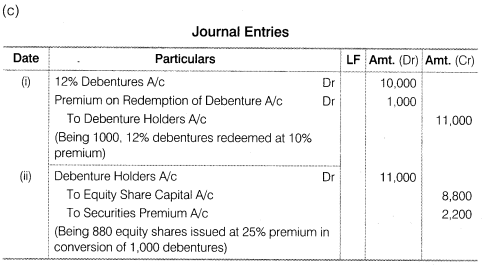

5. On 31.1.2005 Janta Ltd. converted its Rs.88,00,000, 6% debentures into equity shares of Rs.20 each at a premium of Rs.2 per share. Record necessary journal entries in the books of the company for redemption of debentures.


6. Anirudh Ltd. has 4,000, 8% debentures of Rs.100 each due for redemption on March 31, 2005. The company has a debenture redemption reserve of Rs.1,50,000 on that date. Assuming that no interest is due record the necessary journal entries at the time of redemption of debentures.

Working Note
Debenture forRs.4,00,000 were to be redeemed. As per SEBI guidelines, 50% debenture redemption reserve is to be maintained. For Rs.14,00,000 it comes to Rs.2,00,000. Debenture redemption reserve already in books of account was Rs.1,50,000. Hence, entry for balance Rs. 50,000 was passed in this solution.
SHORT ANSWER TYPE QUESTIONS
Question 1. What is meant by a Debenture?
Answer Debenture The word ‘Debenture’ has been derived from a Latin word ‘debere’ which means to borrow.
Debenture is a written instrument acknowledging a debt under the common seal of the company. It contains a contract for repayment of principal after a specified period or at intervals or at the option of the company and for payment of interest at a fixed rate payable usually either half-yearly or yearly on fixed dates.
According, to Section 2(12) of The Companies Act, 1956 ‘Debenture’ includes Debenture Stock, Bonds and any other securities of a company whether constituting a charge on the assets of the company or not.
Question 2. What does a Bearer Debenture mean?
Answer Bearer debentures are the debentures which can be transferred by way of delivery and the company does not keep any record of the debenture holders. Interest on debentures is paid to a person who produces the interest coupon attached to such debentures.
Question 3. State the meaning of ‘Debentures issued as a Collateral Security’.
Answer Collateral security is given in addition to the primary security to the loan provider. In case when a company takes some loan it may issue debentures for additional security besides the primary security to that particular bank or financial institution.
Here it is to be remember that issue of debenture in ordinary course is different from issue of debenture as collateral security, in ordinary course debenture holders are entitled to get interest at an specified coupon rate where as in case of debenture issued as collateral security the holder of these debenture is not entitled to any such interest.
But in case of any default in payment of principle or interest of loan it may recover its amount from the issue of such debenture in the secondary market. Here it should be remembered that first of all the primary security will be sold after that debenture as collateral security will be used.
Question 4. What is meant by Issue of debentures for consideration other than Cash’?
Answer When a company purchase some assets it is supposed to pay the purchase consideration in cash but sometimes due to lack of sufficient fund, company may issue debenture for the payment of such purchase consideration. This is known as issue of debenture for consideration other than cash.
The issue of debenture for consideration other than cash serves the purpose of both the vendor as well as of the purchaser (company). From the purchaser’s point of view, purchasing an asset against the issue of debentures requires no additional cost for raising loans or arranging funds immediately.
On the other hand, the vendor gets interest on the amount of debentures received. In this case, payment is deferred by issue of debentures and interest is paid for time lag. Here it should be remembered that such debentures may be issued at par, premium or discount to the vendor.
Question 5. What is meant by ‘Issue of debentures at discount and redeemable at premium?
Answer As per the prevailing market circumstances sometimes company has to manage funds by issuing debenture below its par value and to attract the investor when these are redeemed at price higher than its par value, then it is termed as issue of debenture at discount and redeemable at premium.
The difference between the issue price and the redemption price is treated as loss on issue of debenture and posted in assets side of the company as miscellaneous expenditure. To have a better understanding about the issue we may take an example as follows
Example: A 10% debenture of ? 100 each is issued at 5% discount and is redeemed at 5% premium. The following Journal Entry will be passed for that
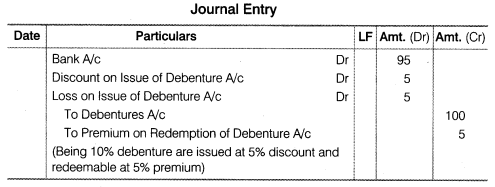
Question 6 What is ‘Capital Reserve’?
Answer Capital Reserve is a reserve that is created out of capital profits. Capital profits are those profits arising out of those activity which are not part of the business operations e.g., premium on issue of share and debentures, profits of sale of fixed asset, profit on redemption on debenture and profit on reissue of forfeited share and so on.
A capital reserve can be utilised for meeting the future capital losses. Here it is to be remembered that capital reserve cannot be used for distributing dividend to the share holders but bonus shares can be issued out of the capital reserve.
Question 7 What is meant by a ‘Irredeemable Debenture?
Answer Irredeemable Debentures are those debentures which may not be redeemed during the life of a Company. They can only be paid off in the event of winding up of the Company. The holder of such debenture will enjoy interest on these debentures throughout the life of the company. Now-a-days no company issue irredeemable debentures.
Question 8. What is a ‘Convertible Debenture?
Answer Convertible Debentures are those debentures which are convertible in equity shares after some specified time generally mentioned at the time of issue of such debentures. These convertible debentures are divided into two categories
(i) Partly Convertible Debenture: In this type of debenture only a part of such debenture is convertible in equity shares which is mentioned at the time of issue.
(ii) Fully Convertible Debenture :These are fully convertible into equity shares. It means in case of fully convertible debenture the whole amount of such debenture, is convertible in equity share after the period mentioned in the prospectus.
Question 9. What is meant by ‘Mortgaged Debentures?
Answer Debentures which are secured against asset/s of a company known as Mortgaged Debenture. Mortgage Debentures are of two types first fixed charge mortgage debenture and second floating charge mortgage debentures.
When debentures are secured against a particular asset, then they are called fixed charge whereas, if the debentures are secured against all the assets of a company, then it is called floating charge. Mortgage debentures can only be sold by the holder when company fails to pay its loan or interest there on.
Question 10. What is discount on issue of debentures?
Answer Debenture is said to have been issued at discount where an applicant is required to pay a total sum less than the face value of the debenture. The excess of the face value over the issue price is regarded as the discount. When debentures are issued at a discount, cash account is debited with net sum received, the discount on debentures account is debited with the amount of discount allowed and the debentures account is credited with the full nominal value of the debentures.
Here it is worth mentioning that there is no legal restriction on the companies for issuing debentures at discount. Maximum limit for discount on debentures is also not prescribed by the Companies Act. However, this Act requires that the amount of discount must be shown on the assets side of the Balance Sheet till written off under the head “Miscellaneous Expenditure.”
Question 11. What is meant by ‘Premium on Redemption of Debentures’?
Answer When the debentures are redeemed at a price more than its face value or the par value, then it is said that the debentures are redeemed at premium. The difference between the redeemed price and the par value is regarded as a capital loss and this loss is written off till the redemption of the debentures.
The Premium on Redemption of Debenture is shown on the Liabilities side of the Balance Sheet under the head of “Current Liabilities and Provisions” debentures are redeemed. –
Question 12. How debentures are different from shares? Give two points.
Answer Nature: A share is a part of the capital of the company and a debenture is a part of loan of the company.
Dividend or Interest :Dividend on shares is paid only when there are profits in
the company on the other hand debenture interest has to be paid, it the company does not have profit or even suffer a loss.
Ownership Equity share holders are the owners of the company on the other hand debenture holders are the creditors of the company.
Question 13. Name the head under which ‘Discount on Issue of Debentures’ appears in the Balance Sheet of a company.
Answer As we know that Discount on Issue of debentures is a capital loss and it will be written off out of the profit of coming years, Therefore, it is shown on the Assets side of the Balance Sheet under the heading of “Miscellaneous Expenditures” until it is written off.
Question 14. What is meant by redemption of debentures ?
Answer The term redemption implies the discharge of an obligation arising out of the contractual obligations created through the debenture Trust Deed. In other words, discharge of the liability on account of debentures is called redemption of debenture.
The redemption of debentures is made by the company in accordance with the terms and conditions of issue. Debentures may be redeemable at par, premium or discount, but in present scenario redemption of debentures at par and at premium is most popular. The redemption can be done out of profits or from the fresh issue of debentures or shares.
Redemption of debentures may be done by the following methods
(i) By paying after stipulated period
(ii) By annual drawing
(iii) By conversion into shares or new debentures
(iv) By purchasing own debentures in the open market
(v) At the option of the company
Question 15. Can the company purchase its own debentures?
Answer Yes, a company, if authorised by its Articles of Association, can purchase its own debentures in the open market. The main purposes of such purchase may be as follows
(i) A company may purchase its own debenture for immediate cancellation for reducing the debenture liability especially in case when the interest rate on its debenture is higher than the market rate of interest.
(ii) A company may also purchase its own debentures with the motive of investment and sell them at higher price in future and thereby earn profit.
Question 16. What is meant by redemption of debentures by conversion?
Answer Debentures are usually redeemed in cash but sometimes privilege is given to the debenture holders to exchange their debentures either for shares or for new debentures of the company. The redemption of debentures by means of shares or new debentures is known as redemption by conversion and the debentures which carry such a right is called convertible debentures.
Question 17. How would you deal with ‘Premium on Redemption of Debentures?
Answer When the debentures are redeemed at a price more than its face value or the par value, then it is said that the debentures are redeemed at premium. The difference between the redeemed price and the par value is regarded as a capital loss and this loss is written off till the redemption of the debentures.
The Premium on Redemption of Debenture is shown on the Liabilities side of the Balance Sheet under the head of Current Liabilities and Provisions until debentures are redeemed.
Accounting Treatment for Premium on Redemption on Debentures



Question 18. What is meant by ‘Redemption out of Capital’?
Answer: When debentures are redeemed out of current resources, the working capital of the company are reduced to that extent, and therefore, it is called redemption out of capital.
In other words when debentures are redeemed out of capital and no profits are utilised for redemption, then such redemption is termed as redemption out of capital.
A company cannot redeem its debentures purely out of capital. At least 50% of debentures issued must be redeemed out of profits by creating a ‘Debenture Redemption Reserve’ and the balance of debentures issued may be redeemed out of profits or out of capital.
According to the Companies Act, 1956 when debentures are to be redeemed an adequate amount of profits is required to be transferred to ‘Debenture Redemption Reserve’ every year before the redemption begins. It is to be noted that the Companies Act, 1956 does not spell out at to what is the adequate amount.
For this one can refer to SEBI Guidelines which stipulates that an amount equal to 50% of the issue of the debentures should be transferred to ‘Debenture Redemption Reserve’ before the redemption begins.
There are exceptions in the following cases
(i) Infrastructure companies (i.e., those companies that are engaged in the business of developing, maintaining and operating infrastructure facilities)
(ii) A company that issues debentures with a maturity up to 18 months.
(iii) In case of Convertible debentures and convertible portion of partly convertible debentures
Question 19. What is meant by redemption of debentures by ‘Purchase in the Open Market?
Answer: A company, if authorised by its Articles of Association, can redeem its own debentures by purchasing them in the open market. This is advantageous for several reasons
(I) It would be saving the amount of interest on debentures purchased and cancelled.
(ii) Sometimes the own debentures are being sold at a discount. It would enable the company to save money equai to the amount of discount i.e., profit on redemption of debentures.
(iii) Debentures so purchased may be kept alive as investment. In need of fund, they can again be sold off in the market.
Objectives There may be the following objectives foP purchasing own debentures in the open market
(i) For immediate cancellation of debentures.
(ii) For investment in the own debentures.
Question 20. Under which head is the ‘Debenture Redemption Reserve’ shown in the Balance Sheet.
Answer The Debenture Redemption Reserve is shown on the Liabilities side of the Balance Sheet under the head Reserve and Surplus.
LONG ANSWER TYPE QUESTIONS
Question 1. What is meant by a debenture? Explain the different types of debentures?
Answer Debenture: The word ‘Debenture’ has been derived from a Latin w’ord ‘Debere’ which means to borrow. Debenture is a written instrument acknowledging a debt under the common seal of the company. It contains a contract for repayment of principal after a specified period or at intervals or at the option of the company and for payment of interest at a fixed rate payable usually either half-yearly or yearly on fixed dates.
According, to Section 2(12) of The Companies Act, 1956 ‘Debenture’ includes Debenture Stock, Bonds and any other securities of a company whether constituting a charge on the assets of the company or not. There are various types of Debentures.
(i) From Security Point of View :From security point of view debentures can be classified into two broad categories naked or simple debentures and Mortgaged debentures.
(a) Naked or Simple Debentures :Naked or Simple Debentures are those debentures which do not carry any security in respect of repayment of interest or the principal. The general solvency of the company is the only security for the holders of simple debentures.
(b) Mortgaged Debentures: Mortgaged Debentures are the debentures which are secured by a charge on the asset or properties of the company. The debenture holders have the right to recover their principal amount as well as unpaid interest out of the assets mortgaged by the company.
In case of mortgage debentures, a company may prefer to appoint trustees who will hold the property given by way of security in trust for the benefits of debentures holders.
(ii) From Permanence Point of View the debentures may be Redeemable or Irredeemable debentures.
(a) Redeemable Debentures Redeemable debentures provide for the payment of principal amount on the expiry of certain period. Redeemable debentures can be reissued even after they have been redeemed until they have been cancelled.
(b) Irredeemable Debentures Irredeemable Debentures are retained as a part of the permanent capital structure during the life time of the company. Such debt becomes due for payment only when the company goes into liquidation or when the payment of interest is not made regularly.
The company has the option of cancelling its liability to the debenture holders at any time by giving due notice to them.
(iii) From Priority Point of View :From this point of view the debentures may be First and Second debentures.
(a) First Debentures :First Debentures are those debentures which are paid first before any payment is made to another type of debentures.
(b) Second Debentures: Second Debentures are those debentures which are paid after making the payment of first debentures.
(iv) From Recording Point of View :From recording point of view debentures can be classified into two categories bearer and registered debentures.
(a) Bearer Debentures :Bearer Debentures are transferable per bearer without endorsement and they are just like bearer cheques or government currency notes. They are treated as negotiable instrument and transferable by mere delivery. It is not necessary that transfer of such debentures should be registered with the company. The interest is paid to the holder irrespective of identity.
(b) Registered Debentures: Registered debentures are made out in the name of a particular person who is registered by the company as a holder and are transferable in the same way as shares.
The payment of interest and repayment of capital is made to those whose name are registered with the company and duly entered in the register of debenture holders.
(v) From Conversion Point of View: From conversion point of view debentures may be convertible or non-convertible.
(a) Convertible Debentures :Convertible debenture holders are given an option to convert them into equity or preference shares at a stated rate of exchange after a certain period. Convertible debentures are very popular these days with the companies as it provides them a major source of permanent working capital. It also provides safety, liquidity, capital appreciation and assured return to the investors.
(b) Non-Convertible Debentures: Non-convertible debentures are not convertible into equity or preference shares afterwards.
Question 2. Distinguish between a debenture and a share. Why debenture is known as loan capital? Explain.

Question 3. Describe the meaning of ‘Debenture Issued as Collateral Securities’. What accounting treatment is given to the issue of debentures in the books of accounts?
Answer When a company takes a loan, it has to give some security, it may do so by giving debentures to the party from whom loan is takes. If on the due date principal is paid back by the Company and interest is also paid, the loan-giver will return the debentures to the Company and then they will be cancelled by the Company,
If the Company makes a default, the bank may either keep the debenture and become debenture-holder or sell them and realise money. This type of issue by the Company is called Issue of Debenture as Collateral Security.
When debentures are issued by the company, they are not really alive and no accounting entry is made in the books of the Company for it. Only a note is given in the balance sheet for it as under

If an accounting record for these debentures is to be made Debentures Suspense A/c is debited and deoentures A/c credited, debentures are shown in the liability side and balance of debentures Suspense A/c is shown in the assets side of the Balance Sheet. When debt is paid off by the Company, Debentures A/c is debited and Debentures Suspense A/c is credited.
Question 4. How is ‘Discount on Issue of Debentures’ treated in the books of accounts? How will you deal with the ‘Discount on issue of debentures’ when the debentures are to be redeemed in instalments?
Answer When the debentures are issued at a price below its par value or face value, then it is said that the debentures are issued at discount. The difference between the issue price and the face value of the debenture is regarded as a capital loss. This loss is written off every year till the debentures are redeemed.
The loss on the issue of debenture is shown on the Assets side of the Balance Sheet under the heading of Miscellaneous Expenditures.
Accounting Treatment for Discount on Issue of Debentures:
At the time of issue of debentures at discount

At the time of writing off the discount on issue of debentures at the end of each year

(i) Fixed Instalment Method/Equal Instalment Method : This method is used when debentures are redeemable in lump sum after a specified period of time. In this case an equal amount of discount (loss) is written off in equal instalments over the life of the debenture. The formula for calculating amount of discount written off every year is given below

(ii) Fluctuating Instalment Method/Variable Instalment Method/ Proportion Method: When debentures are repaid by annuaLdrawings or in instalments, the discount should be written-off in the ratio of
debentures outstanding as at the end of each accounting year. The amount of discount, under this method, goes on reducing every year and so this method may also be known as Reducing Instalment Method. –
e.g., if a company has issued 10% debentures of Rs. 12,00,000 at 5% discount redeemable annually by Rs. 2,40,000 each year. The total amount of discount on Rs.12,00,000 debentures @ 5% is Rs. 60,000, i.e., (12,00,000 x 5/100 =Rs. 60,000). The amount of discount to be written off every year is calculated as

Hence, the amount of the total discount of’ 60,000 will be written off in the ratio of ,5 : 4 : 3 : 2 :1 i.e.,’ 20,000,’ 16,000,’ 12,000,’ 8,000 and 4,000 respectively.
Question 5. Explain the different terms for the issue of debentures with reference to their redemption.
Answer Debentures can be issued at par, at premium and at discount in the same way they can be redeem at par and at premium. Debentures can never be redeemed at discount. The following are the six situation under which debentures can be issued to their redemption.
(i) Issue at Par and Redeemable at Par: When the debentures are issued and are redeemed at their face value, then the following Journal entry is passed.

(ii) Issue at Premium and Redeemable at Par When the debentures are issued at premium and redeemable at par, then the following Journal entry is passed. As premium is a gain for a company so it is credited in the Journal entry.
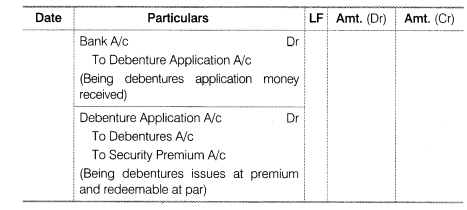
(iv)Issue at Discount and Redeemable at Par When the debentures are issued at discount and redeemable at par, then the following Journal entry is passed. As discount is a loss for a company so it is debited in the Journal entry.

(v) Issue at Premium and Redeemable at Premium When debentures are issued at par and redeemable at premium, then the following Journal entry is passed. In such case, the company did not suffer any loss at the time of issue but there will be loss at the time of redemption.
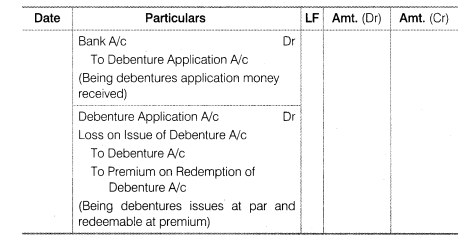
(vi) Issue at Discount and Redemption at Premium When the debentures are issued at discount and redeemable at premium, then the following Journal entry is passed.

Question 6. Differentiate between redemption of debentures out of capital and out of profits.
Answer Debentures can be redeemed out of capital and out of profits. The following are the difference between these two methods.
Redemption of Debentures Out of Capital: This is the situation where debentures are redeemed out of capital and no profits are utilised for redemption of the debentures, such redemption is termed as redemption out of capital. In this situation, no profits are required to be transferred to the Debenture Redemption Reserve (DRR).
Here it is to be remembered that no company can redeem its debenture purely out of capital because as per the guideline laid down by Securities and Exchange Board of India (SEBI) and the Section 117C of Company Act of 1956, before starting any redemption process a company is required to create a DRR equal to 50% of the debentures issued).
Therefore, it is not possible to redeem debentures purely out of capital, as it reduces the value of assets. There are exceptions in the following case
(i) Infrastructure companies (i.e., those companies that are engaged in the business of developing, maintaining and operating infrastructure facilities)
(ii) A Company that issues debentures with a maturity up to 18 months.
(iii) In case of convertible debentures and convertible portion of partly convertible debentures.
Redemption of Debenture Out of Profits:When debentures are redeemed out of profit then no capital is utilised for redemption. Before redeeming the debentures profits are transferred to DRR from Profit and Loss Appropriation Account. The creation of DRR is mandatory as per the guidelines laid down by Securities and Exchange Board of India (SEBI).
SEBI mandates transferring amount equal to 50% of debentures issued to DRR before redeeming debentures. As transfer of amount (profits) to the DRR from Profit and Loss Appropriation Account reduces the amount of profit available for distribution of dividend, so this redemption process is known as redemption out of profit.
DRR is shown under the head of Reserves and Surpluses on the Liabilities side of the Balance Sheet. DRR account is closed by transferring it to General Reserve only when all the debentures are redeemed.
Question 7. Explain the guidelines of SEBI for creating Debenture Redemption Reserve.
Answer Securities and Exchange Board of India (SEBI) have provided some guidelines for redemption of debentures. The focal points of these guidelines are *
(i) Every company shall create Debenture Redemption Reserve in case of issue of debenture redeemable after a period of more than 18 months from the date of issue.
(ii) The creation of Debenture Redemption Reserve is obligatory only for non-convertible debentures and non-convertible portion of partly convertible debentures.
(iii) A company shall create Debenture Redemption Reserve equivalent to at least 50% of the amount of debenture issue before starting the redemption of debenture.
(iv) Withdrawal from Debenture Redemption Reserve is permissible only after 10% of the debenture liability has already been reduced by the company.
SEBI guidelines would not apply under the following situations:
(i) Infrastructure company (a company wholly engaged in the business of developing, maintaining and operating infrastructure facilities), and
(ii) A company issuing debentures with a maturity period of not more than 18 months.
Question 8. Describe the steps for creating Sinking Fund for redemption of debentures.
Answer The steps involved in creation of Sinking Fund on redemption of Debenture are
(i) Calculate the amount of profit to be set-aside annually with the help of sinking fund table.
(ii) Set aside the amount of profit at the end of each year and credit to Debenture Redemption Fund (DRF) Account.
(iii) Purchase the investments of the equivalent amount at the end of first year and debit Debenture Redemption Fund Investment (DRFI) Account.
(iv) Receive interest on investment at the end of each subsequent year.
(v) Purchase the investments equivalent to the fixed amount of profit set aside and the interest earned every year except last year (year of redemption).
(vi) Receive interest on investment for the last year.
(vii) Set aside the fixed amount of profit for the last year.
(viii) Encash the investments at the end of the year of redemption.
(ix) Transfer the profit/loss on sale of investments reflected in the balance of Debenture Redemption Fund Investment Account to Debenture Redemption Fund Account.
(x) Make payment to debenture holders.
(xi) Transfer Debenture Redemption Fund A/c balance to General Reserve.
Question 9. Can a company purchase its own debentures in the open market? Explain.
Answer Yes, a company, if authorised by its Articles of Association, can purchase its own debentures in the open market. The main purposes of such purchase may be as follows
(i) A company may purchase its own debenture for immediate cancellation for reducing the debenture liability especially in case when the interest rate on its debenture is higher than the market rate of interest.
(ii) A company may also purchase its own debentures with the motive of investment and sell them at higher price in future and thereby earn profit.
When a company purchase its own debenture,in the open market it can happen in either of the two ways first debentures may be purchased at premium for cancellation and debenture may be purchase at discount for cancellation. The following will be the accounting treatment in both situation.
(i) If Debentures are Purchased at Discount for Cancellation :When the company purchase its own debentures at discount for cancellation, then the following Journal entries are recorded.

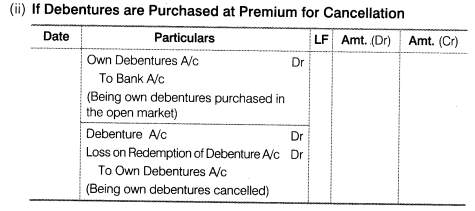
Question 10. What is meant by conversion of debentures? Describe the method of such a conversion.
Answer The debentures can also be redeemed by converting them into shares or new debentures. If debenture holders find that the offer is beneficial to them they may convert his/her debentures into shares or new debentures after the expiry of a specified period of time, then this whole process is known as redemption of debentures by conversion.
It is worth mentioning here that in such a case no Debenture Redemption Reserve is required because no funds are required for redemption.
If a debenture holder exercises the conversion option, then the issue price of shares must be equal to or less than the amount .actually received from debentures. The accounting treatment in that case will be as follows:

NUMERICAL PROBLEMS
1. G.Ltd. issued 75,00,000, 6% Debenture of Rs.50 each at par payable Rs.15 on application and Rs.35 on allotment, redeemable at par after 7 years from the date of issue of debenture. Record necessary entries in the books of Company.
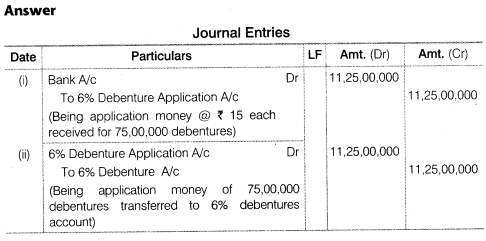

2. Y.Ltd. issued 2,000, 6% Debentures of Rs.100 each payable as follows: Rs.25 on application; Rs.50 on allotment and Rs.25 on First and Final call.

3. A.Ltd. issued 10,000, 10% Debentures of Rs.100 each at a premium of 5% payable as follows:
Rs.10 on Application;
Rs.20 along with premium on allotment and balance on First and Final call.
Record necessary Journal Entries.

4. A. Ltd. issued 90,00,000, 9% Debenture of Rs.50 each at a discount of 8%, redeemable at par any time after 9 years. Record necessary entries in the books of A. Ltd.

5. A.Ltd. issued 4,000, 9% Debentures of Rs.100 each on the following terms:
Rs.20 on Application;
Rs.20 on Allotment;
Rs.30 on First call; and
Rs.30 on Final call.
The public applied for 4,800 Debentures. Applications for 3,600 Debentures were accepted in full. Applications for 800 Debentures were allotted 400 Debentures and applications for 400 Debentures were rejected.
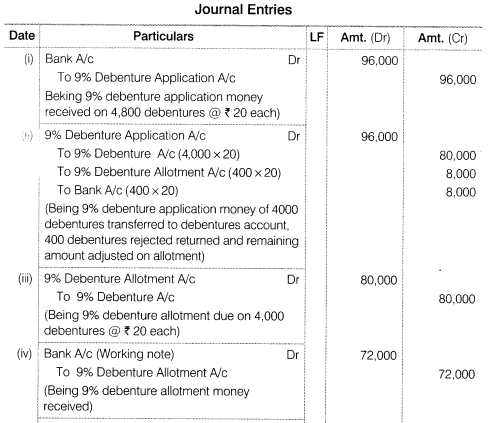


6. T. Ltd. offered 2,00,000, 8% Debenture of Rs.500 each on June 30, 2002 at a premium of 10% payable as Rs.200 on application (including premium) and balance on allotment, redeemable at par after 8 years. But application are received for 3,00,000 debenture and the allotment is made on pro-rata basis. All the money due on application and allotment is received. Record necessary entries regarding issue of debenture.

7. X.Ltd. invites application for the issue of 10,000, 14% debentures of Rs.100 each payable as to Rs.20 on application, Rs.60 on allotment and the balance on call. The company receives applications for 13,500 debentures, out of which applications for 8,000 debentures are allotted in full, 5,000 only 40% and the remaining rejected. The surplus money on partially allotted applications is utilised towards allotment. All the sums due are duly received.
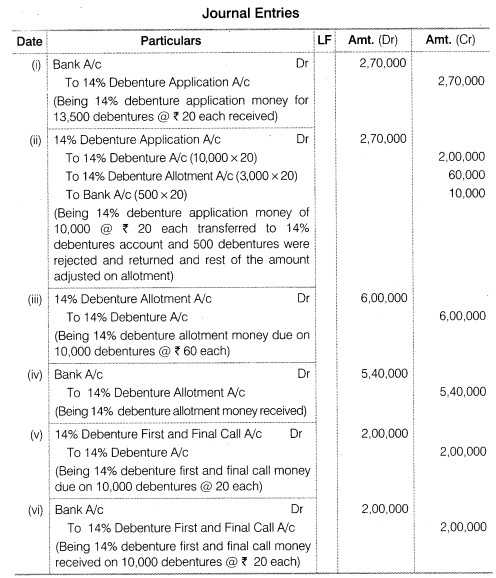
8. R.Ltd. offered 20,00,000, 10% Debenture of Rs.200 each at a discount of 7% redeemable at premium of 8% after 9 years. Record necessary entries in the books of R. Ltd.

9. M.Ltd. took over assets of Rs.9,00,00,000 and liabilities of Rs.70,00,000 of S.Ltd. and issued 8%Debenture of Rs.100 each. Record necessary entries in the books of M. Ltd.
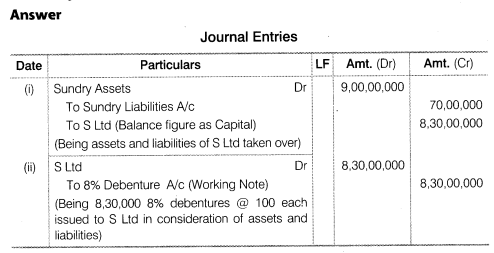

10. B.Ltd. purchased assets of the book value of Rs.4,00,000 and took over the liability of Rs.50,000 from Mohan Bros. It was agreed that the purchase consideration, settled at Rs,3,80,000, be paid by issuing debentures of Rs.100 each. What Journal entries will be made in the following three cases, if debentures are issued: (a) at par; (b) at discount; (c) at premium of 10%? It was agreed that any fraction of debentures be paid in cash.






11. X.Ltd. purchased a Machinery from Y for an agreed purchase consideration of
Rs.4,40,000 to be satisfied by the issue of 12% debentures of Rs.100 each at a premium of Rs.10 per debenture. Journalise the transactions.


12. X.Ltd. issued 15,000, 10% debentures of Rs.100 each. Give journal entries and the Balance Sheet in each of the following cases:
(i) The debentures are issued at a premium of 10%;
(ii) The debentures are issued at a discount of 5%;
(iii) The debentures are issued as a collateral security to bank against a loan of Rs.12,00,000; and
(iv) The debentures are issued to a supplier of machinery costing Rs.13,50,000.










13. Journalise the following:
(i) A debenture issued at Rs.95, repayable at Rs.100;
(ii) A debenture issued at Rs.95, repayable at Rs.105; and
(iii) A debenture issued at Rs.100, repayable at Rs.105;
The face value of debenture in each of the above cases is Rs.100.

14. A.Ltd. issued 50,00,000, 8% Debenture of Rs.100 at a discount of 6% on April 01,
2000 redeemable at premium of 4% by draw of lots as under:
20,00,000 Debentures on March, 2002
10,00,000 Debentures on March, 2004
20,00,000 Debentures on March, 2005
Compute the amount of discount to be written-off in each year till debentures are
paid. Also prepare discount/loss on issue of debenture account.


15. A company issues the following debentures:
(i) 10,000, 12% debentures of Rs.100 each at par but redeemable at premium of 5% after 5 years;
(ii) 10,000, 12% debentures of Rs.100 each at a discount of 10% but redeemable at par after 5 years;
(iii) 5,000, 12% debentures of Rs.1000 each at a premium of 5% but redeemable at par after 5 years;
(iv) 1,000, 12% debentures of Rs.100 each issued to a supplier of machinery costing Rs.95,000. The debentures are repayable after 5 years; and
(v) 300, 12% debentures of Rs.100 each as a collateral security to a bank which has advanced a loan of Rs.25,000 to the company for a period of 5 years. Pass the journal entries to record the: (a) issue of debentures; and (b) repayment of debentures after the given period.
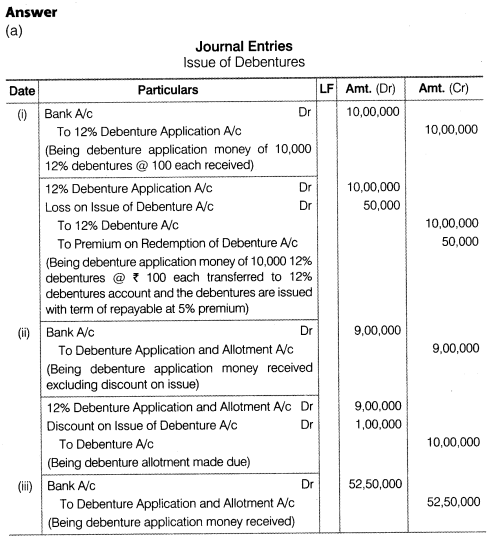
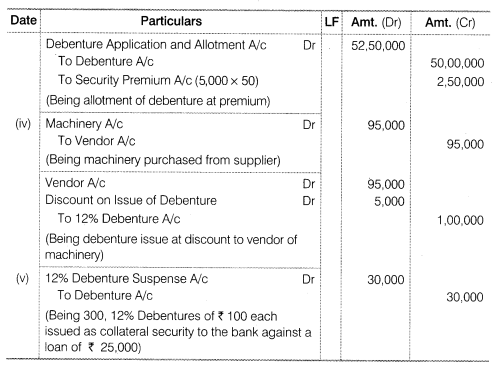


16. A company issued debentures of the face value of Rs,5,00,000 at a discount of 6% on January 01, 2001. These debentures are redeemable by annual drawings of Rs,1,00,000 made on December 31 each year. The directors decided to write off discount based on the debentures outstanding each year.
Calculate the amount of discount to be written-off each year. Give journal entries
also.



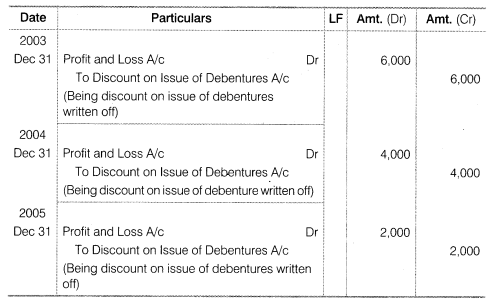
17. A company issued 10% Debentures of the face value of Rs,1,20,000 at a discount of 6% on January 01, 2001. The debentures are payable by annual drawings of Rs.40,000 commencing from the end of third year.
How will you deal with discount on debentures? Show the discount on debentures account in the company ledger for the period of duration of debentures. Assume accounts are closed on December 31.


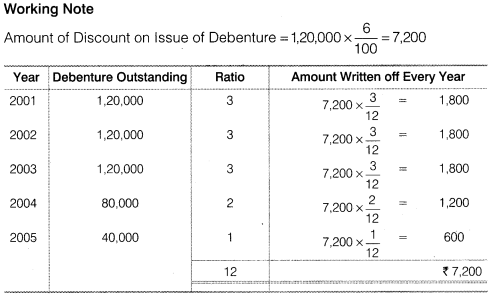
18. B.Ltd. issued debentures at 94% for Rs.4,00,000 on April 01, 2000 repayable by five equal drawings of Rs.80,000 each. The company prepares its final accounts on December 31 every year.
Indicate the amount of discount to be written-off every accounting year assuming that the company decides to write off the debentures discount during the life of debentures. (Amount to be written-off: 2000 Rs.6,000; 2001 Rs.6,800; 2002 Rs.5,200; 2003 Rs.3,600; 2004 Rs.2,000; 2005 Rs.400).



19. B. Ltd. issued 1,000, 12% debentures of Rs.100 each on January 01, 2005 at a discount of 5% redeemable at a premium of 10%. Give journal entries relating to the issue of debentures and debentures interest for the period ending December 31, 2005 assuming that interest is paid half yearly on June 30 and December 31 and tax deducted at source is 10%. B.Ltd. follows calendar year as its accounting year.


20. What journal entries will be made in the following cases when company redeems debentures at the expiry of period by serving the notice: (a) when debentures were issued at par with a condition to redeem them at premium; (b) when debentures were issued at premium with a condition to redeem that at par; and (c) when debentures were issued at discount with a condition to redeem them at premium?


21. On January 01, 1998, X. Ltd. issues 5,000, 8% Debentures of Rs.100 each repayable at par at the end of three years. It has been decided to set up a cumulative sinking fund for the purpose of their redemption. The investments are expected to realise 4% net. The Sinking Fund Table shows that Rs.0.320348 amounts to one rupee @4% per annum in three years. On December 31, 2000 the balance at bank was Rs.2,42,360 and the investments realised Rs.3,25,000. The debentures were paid off. Give journal entries and show ledger account.



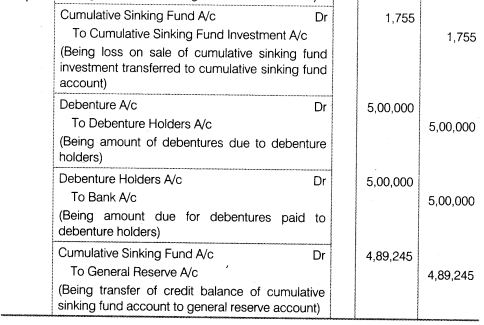
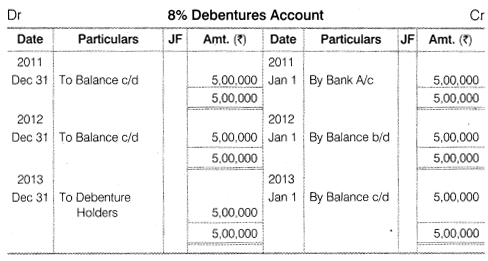

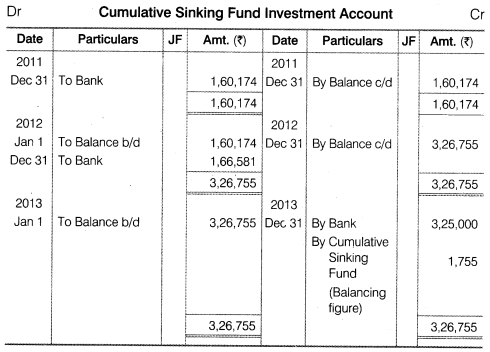


22. On January 01, 2003 a company issued 15% debentures of Rs.10,00,000 at par. The debentures were redeemable at par after three years on December 31, 2003. A sinking fund was set up to raise funds for redemption of debentures. The amount for the purpose was invested in 6% Government securities of Rs.100 each available at par. The sinking fund table shows that if investments earn 6% per annum, to get Re.1 at the end of 3 years, one has to invest Rs.0.31411 every year together
with interest that will be earned. On December 31, 2005, all the Government securities were sold at a total loss of Rs. 6,000 and the debentures were redeemed at par. Prepare Debentures Account Sinking Fund Account, Sinking Fund Investment Account and Interest on Sinking Fund Investment Company closes its books of accounts every year on December 31.


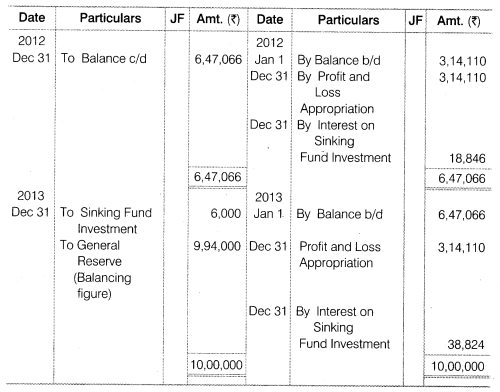


23. On January 01, 2004 the following balances appeared in the books of Z. Ltd.:

The investments consisted of 4% Government securities of the face value of Rs.90,000. The annual instalment was Rs.16,400. On December 31, 2004, the balance at Bank was Rs.26,000 (after receipt of interest on D.R.Reserve Fund Investment). Investments were realised at 92% and the Debentures were redeemed. The interest for the year had already been paid. Show the ledger accounts affecting redemption.


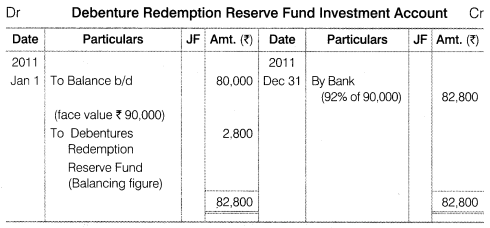
24. The following balances appeared in the books of A.Ltd. on January 01, 2004

On January 01, 2004, the company redeemed all the debentures at 105 per cent out of funds raised by selling all the investments at Rs.3,48,000. Prepare the necessary ledger accounts.






25. The following balances appeared in the books of Z.Ltd. on January 01, 2004

The annual instalment added to the fund is Rs.20,575. On December 31, 2004, the bank balance after the receipt of interest on the investment was Rs.39,100. On that date, all the investments were sold at 83 per cent and the debentures were duly redeemed. Show the necessary ledger accounts for the year 2004.





26.What entries for the redemption of debentures will be done when : (a) debentures
are redeemed by annual drawings out of profits; (b) debentures are redeemed by
drawing a lot out of capital; and (c) debentures are redeemed by purchasing them
in the open market when sinking fund for the redemption of debentures is not
maintained – (i) when out of profit, and (ii) when out of capital?


27. A. Ltd. Company issued Rs,5,00,000 Debentures at a discount of 5% repayable at
par by annual drawings of Rs.1,00,000.
Make the necessary ledger accounts in the books of the company for the first year.



28. X.Ltd. issued 5,000, 15% debentures of Rs.100 each on January 01, 2004 at a
discount of 10%, redeemable at a premium of 10% in equal annual drawings in 4
years out of capital.
Give journal entries both at the time of issue and redemption of debentures.
(Ignore the treatment of loss on issue of debentures and interest.)


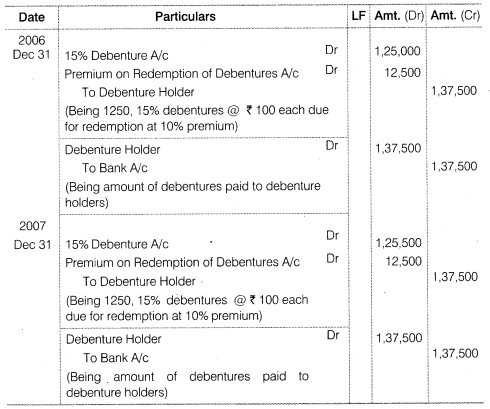

29. Z.Ltd. issued 2,000, 14% debentures of Rs.100 each on January 01, 2005 at a
discount of 10%, redeemable at a premium of 10% in equal annual drawings in 4
years out of profits.
Give journal entries both at the time of issue and redemption of debentures.
(Ignore the treatment of loss on issue of debentures and interest.)


30. A.Ltd. purchased its own debentures of the face value of Rs.2,00,000 from the
open market for immediate cancellation at Rs.92. Pass the journal entries.


31.A.Ltd. purchased for cancellation Rs.50,000 of its 15% debentures at Rs.98. The expenses of purchase amounted to Rs.50. On January 01, 2002, X.Ltd. issued 40,000, 9% debentures of Rs.100 each at Rs.95. The terms of issue provided that, beginning with 1999, Rs.2,00,000 debentures
should be redeemed either by drawings at par or by purchase in the open market every year. The expenses of issue amounted to Rs.12,000 which were written-off in 2002. The company also wrote off Rs.40,000 every year from Discount on Debentures Account. At the end of 2004, debentures to be redeemed were repaid by drawings. During 2005, the company purchased for cancellation 2,000 debentures at the market price of Rs.98 on December 31, the expenses being Rs.400. Interest on
debentures is payable at the end of every calendar year. Pass the journal entries in the books of the company to record these transactions.


32. A.Ltd. redeemed 8,000, 12% debentures of Rs.100 each which were issued at a discount of 5%, by converting them into equity shares of Rs.10 each at par.





33. Y.Ltd. redeemed 4,800, 12% debentures of Rs.100 each which were issued at par, at 110 per cent by converting them into equity shares of Rs.10 each issued at a discount of 4%. Journalise.


34. Z.Ltd. redeemed 2,000, 12% debentures of Rs.100 each which were issued at a discount of 5%, by converting them into equity shares of Rs.10 each issued at a premium of 25%. Journalise.


35. X.Ltd. redeemed 1,000, 12% debentures of Rs.50 each by converting them into 15% New Debentures of Rs.100 each. Journalise.
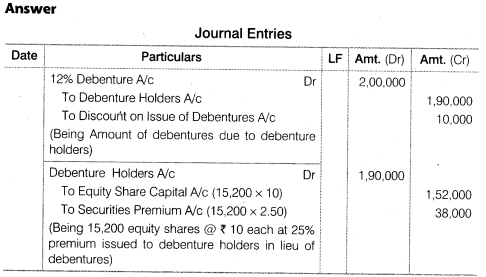

More Resources for CBSE Class 12
RD Sharma Class 12 Solutions
NCERT Solutions for Class 12th English Flamingo
NCERT Solutions for Class 12th English Vistas
CBSE Class 12 Accountancy
NCERT Solutions for Class 12th Maths
CBSE Class 12 Biology
CBSE Class 12 Physics
CBSE Class 12 Chemistry
CBSE Sample Papers For Class 12
NCERT SolutionsAccountancyBusiness StudiesMacro EconomicsCommerce